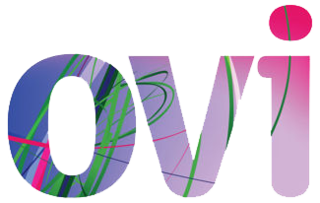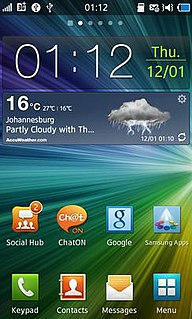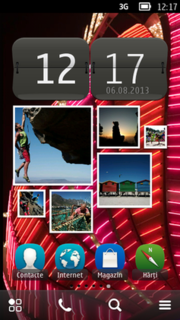Related Research Articles
Adobe Flash is a multimedia software platform used for production of animations, rich web applications, desktop applications, mobile apps, mobile games, and embedded web browser video players. Flash displays text, vector graphics, and raster graphics to provide animations, video games, and applications. It allowed streaming of audio and video, and can capture mouse, keyboard, microphone, and camera input.

Nokia Corporation is a Finnish multinational telecommunications, information technology, and consumer electronics company, founded in 1865. Nokia's main headquarters are in Espoo, Finland, in the greater Helsinki metropolitan area, but the company's actual roots are in the Tampere region of Pirkanmaa. In 2020, Nokia employed approximately 92,000 people across over 100 countries, did business in more than 130 countries, and reported annual revenues of around €23 billion. Nokia is a public limited company listed on the Helsinki Stock Exchange and New York Stock Exchange. It is the world's 415th-largest company measured by 2016 revenues according to the Fortune Global 500, having peaked at 85th place in 2009. It is a component of the Euro Stoxx 50 stock market index.
Adobe Premiere Pro is a timeline-based video editing software application developed by Adobe Inc. and published as part of the Adobe Creative Cloud licensing program. First launched in 2003, Adobe Premiere Pro is a successor of Adobe Premiere. It is geared towards professional video editing, while its sibling, Adobe Premiere Elements, targets the consumer market.
A rich web application is a web application that has many of the characteristics of desktop application software. The concept is closely related to a single-page application, and may allow the user interactive features such as drag and drop, background menu, WYSIWYG editing, etc. The concept was first introduced in 2002 by Macromedia to describe Macromedia Flash MX product. Throughout the 2000-s, the term was generalized to describe web applications developed with other competing browser plugin technologies including Java applets, Microsoft Silverlight.

Alcatel–Lucent S.A. was a French–American global telecommunications equipment company, headquartered in Boulogne-Billancourt, France. It was formed in 2006 by the merger of France-based Alcatel and U.S.-based Lucent, the latter being a successor of AT&T's Western Electric and Bell Labs.
Alcatel is a French brand of mobile handsets owned by Finnish consumer electronics company Nokia and used under license by Chinese electronics company TCL Technology. The Alcatel brand was licensed in 2005 by former French electronics and telecommunications company Alcatel-Lucent to TCL for mobile phones and devices, and the current license expires at the end of 2024. Nokia acquired the assets of Alcatel-Lucent in 2016 and thus also inherited the licensing agreements for the Alcatel brand.

Microsoft Silverlight is a discontinued application framework designed for writing and running rich web applications, similar to Adobe's runtime, Adobe Flash. A plugin for Silverlight is still available for a very small number of browsers. While early versions of Silverlight focused on streaming media, later versions supported multimedia, graphics, and animation, and gave support to developers for CLI languages and development tools. Silverlight was one of the two application development platforms for Windows Phone, but web pages using Silverlight did not run on the Windows Phone or Windows Mobile versions of Internet Explorer, as there was no Silverlight plugin for Internet Explorer on those platforms.

Ovi by Nokia was the brand for Nokia's Internet services. The Ovi services could be used from a mobile device, computer or via the web. Nokia focused on five key service areas: Games, Maps, Media, Messaging and Music. Nokia's aim with Ovi was to include third party developers, such as operators and third-party services like Yahoo's Flickr photo site. With the announcement of Ovi Maps Player API, Nokia started to evolve their services into a platform, enabling third parties to make use of Nokia's Ovi services.

Moblin, short for 'mobile Linux', is a discontinued open source operating system and application stack for Mobile Internet Devices (MIDs), netbooks, nettops and embedded devices.

In telecommunications, Long-Term Evolution (LTE) is a standard for wireless broadband communication for mobile devices and data terminals, based on the GSM/EDGE and UMTS/HSPA technologies. It increases the capacity and speed using a different radio interface together with core network improvements. LTE is the upgrade path for carriers with both GSM/UMTS networks and CDMA2000 networks. The different LTE frequencies and bands used in different countries mean that only multi-band phones are able to use LTE in all countries where it is supported.
Touchatag was an RFID service for consumers, application developers and operators/enterprises created by Alcatel-Lucent. Consumers could use RFID tags to trigger what touchatag called Applications, which could include opening a webpage, sending a text message, shutting down the computer, or running a custom application created through the software's API, via the application developer network. Touchatag applications were also compatible with NFC enabled phones like the Nokia 6212. TikiTag was launched as an open beta on October 1, 2008. And it was rebranded to touchatag on February 15, 2009. Touchatag also sold RFID hardware, like a starter package with 1 USB RFID reader and 10 RFID tags (stickers), for which the client software was compatible with Windows XP and Vista, along with Mac OS X 10.4 and up. Touchatag was carried by Amazon.com, ThinkGeek, Firebox.com and getDigital.de along with Touchatag's own Online Store. Touchatag also marketed their products' underlying technology for enterprise and operator solutions. Touchatag announced an agreement with Belgacom PingPing on jointly developing the contactless market and announced a commercial pilot with Accor Services. On June 27, 2012 the Touchatag team has announced the shutdown of the project. inviting users to use IOTOPE "a similar open source Internet Of Things service" which itself has no apparent activity since November 2012.

Bada is a discontinued operating system for mobile devices such as smartphones and tablet computers. It was developed by Samsung Electronics. Its name is derived from "바다 (bada)", meaning "ocean" or "sea" in Korean. It ranges from mid- to high-end smartphones.

Symbian is a discontinued mobile operating system (OS) and computing platform designed for smartphones. Symbian was originally developed as a proprietary software OS for PDAs in 1998 by the Symbian Ltd. consortium. Symbian OS is a descendant of Psion's EPOC, and was released exclusively on ARM processors, although an unreleased x86 port existed. Symbian was used by many major mobile phone brands, like Samsung, Motorola, Sony Ericsson, and above all by Nokia. It was also prevalent in Japan by brands including Fujitsu, Sharp and Mitsubishi. As a pioneer that established the smartphone industry, it was the most popular smartphone OS on a worldwide average until the end of 2010, at a time when smartphones were in limited use, when it was overtaken by iOS and Android. It was notably less popular in North America.
Movial is a privately held software engineering company focused on Internet enabled devices in consumer electronics and telecommunications industries. The company’s service offering includes device concept and user interface design, third-party application, service and platform integration, consulting, training, product maintenance and support. Device manufacturers and operators leverage Movial’s creative and custom systems integration services, including its Android, MeeGo and Qt (framework)services, to help them increase ROI, and to streamline and speed product development utilizing open Linux platforms and ready-to-use applications.

Solar2D is a free and open-source, cross-platform software development kit originally developed by Corona Labs Inc. and now maintained by Vlad Shcherban. Released in late 2009, it allows software programmers to build 2D mobile applications for iOS, Android, and Kindle, desktop applications for Windows, Linux and macOS, and connected TV applications for Apple TV, Fire TV and Android TV.

CSipSimple is a Voice over Internet Protocol (VoIP) application for Google Android operating system using the Session Initiation Protocol (SIP). It is open source and free software released under the GNU General Public License.

Firefox OS is a discontinued open-source operating system – made for smartphones, tablet computers, smart TVs and dongles designed by Mozilla and external contributors. It is based on the rendering engine of the Firefox web browser, Gecko, and on the Linux kernel. It was first commercially released in 2013.
Adobe Edge is a suite of web development tools developed by Adobe that enhances the capabilities of their other applications, such as Dreamweaver. The first application in the suite was released in August 2011 as a multimedia authoring tool designed to succeed the Flash platform. In September 2012, Adobe renamed the application Edge Animate, and announced Edge Reflow, Edge Code, and Edge Inspect. Also packaged with the suite are Edge Web Fonts, the PhoneGap application, and access to Adobe's Typekit service.
Nokia is a Finnish multinational corporation founded on 12 May 1865 as a single paper mill operation. Through the 19th century the company expanded, branching into several different products. In 1967, the Nokia corporation was formed. In the late 20th century, the company took advantage of the increasing popularity of computer and mobile phones. However, increased competition and other market forces caused changes in Nokia's business arrangements. In 2014, Nokia's mobile phone business was sold to Microsoft.
References
- ↑ "Alcatel-Lucent Q3 2010 results announcement". Alcatel-lucent.com. Retrieved January 16, 2012.
- 1 2 3 "Deloitte Fast 50 France ranking 2009". Fast50france.com. Retrieved January 16, 2012.
- ↑ "Alcatel-Lucent press release". Alcatel-lucent.com. September 1, 2010. Archived from the original on September 30, 2011. Retrieved January 16, 2012.
- 1 2 "Article from Scott Janousek". Flashmobile.scottjanousek.com. May 18, 2009. Retrieved January 16, 2012.
- ↑ Article from Dale Rankine Archived April 20, 2010, at the Wayback Machine
- ↑
- ↑ "Adobe MAX presentation". Archived from the original on January 17, 2010. Retrieved March 5, 2010.
- ↑ "Flash is beautiful article on ELIPS 3.0 at MAX". Flashisbeautiful.com. Archived from the original on April 22, 2012. Retrieved January 16, 2012.
- ↑ "OpenPlug announcement about commercial release of ELIPS Studio". Openplug.com. August 2, 2010. Retrieved January 16, 2012.
- ↑ "ENEA Press Release". Archived from the original on October 1, 2011. Retrieved January 31, 2020.
- ↑ "Intel Moorestown platform to drive smartphones in 2010, Gizmag". Gizmag.com. January 11, 2010. Retrieved January 16, 2012.
- ↑ "CES video of Aava device". Youtube. January 7, 2010. Archived from the original on December 15, 2021. Retrieved January 16, 2012.
- ↑ "Esmertec jBed features specification". Myriadgroup.com. Retrieved January 16, 2012.
- ↑ "India Time Infotech article on Jataayu and Open-Plug licensing agreement". Infotech.indiatimes.com. Retrieved January 16, 2012.[ permanent dead link ]
- ↑ "Electronics Talk article on Jataayu and OP partnership". Electronicstalk.com. September 1, 2004. Archived from the original on March 10, 2011. Retrieved January 16, 2012.
- ↑ "Brian Solomon, Zi Corporation Honored at 20th Annual Mobile Market Development Event, TMCNet". Communication-solutions.tmcnet.com. October 25, 2007. Archived from the original on February 27, 2012. Retrieved January 16, 2012.
- ↑ "WebTimes Media, OpenPlug renforce son ecosysteme". Webtimemedias.com. Archived from the original on September 26, 2010. Retrieved January 16, 2012.
- ↑ Business Oulu, Nuance Communications has acquired nCore [ dead link ]
- ↑ "Electronics Talk article on Sybase iAnywhere and OP integration". Electronicstalk.com. February 13, 2007. Archived from the original on October 8, 2007. Retrieved January 16, 2012.
- ↑ "Electronics Talk article on Beepscience and OP partnership". Electronicstalk.com. December 4, 2006. Archived from the original on October 15, 2008. Retrieved January 16, 2012.
- ↑ "Electronics Talk article on Philips Nexperia partner program". Electronicstalk.com. Archived from the original on November 23, 2008. Retrieved January 16, 2012.
- ↑ "Electronics Talk article on Philips Nexperia and OP integration". Electronicstalk.com. Archived from the original on December 2, 2008. Retrieved January 16, 2012.
- ↑ "TI OMAP VOx 1030 Application Suites partners page". Focus.ti.com. Retrieved January 16, 2012.
- ↑ "Electronics Talk on OP and TI Platforms". Electronicstalk.com. February 13, 2007. Archived from the original on November 23, 2008. Retrieved January 16, 2012.
- ↑ Mobile Europe article on SEMC J132 and OpenPlug [ dead link ]
- ↑ Gohring, Nancy (November 14, 2005). "New mobile Linux group launches, Computerworld". Computerworld.com. Retrieved January 16, 2012.
- ↑ Red Herring 100 Europe 2006 Archived February 1, 2010, at the Wayback Machine
- ↑ "GSMA Asia Mobile Innovation Award". Gsmworld.com. October 17, 2006. Archived from the original on November 13, 2011. Retrieved January 16, 2012.
- ↑ Gohring, Nancy (February 11, 2008). "LiMo gains steam as Mobile Linux of Choice, PC World". Pcworld.com. Retrieved January 16, 2012.
- ↑ "OSEO Innovation prize" (in French). Oseo.fr. Archived from the original on March 1, 2012. Retrieved January 16, 2012.